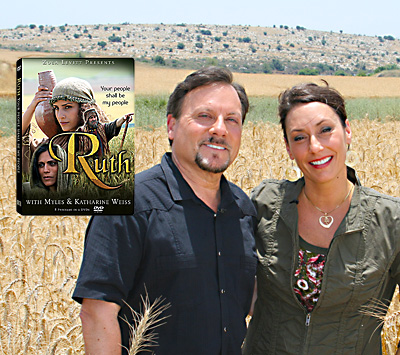
Dear Friends,
“To everything there is a season, and a time to every purpose under heaven.” (Ecc. 3:1–8) This brilliant note from God reminds us that good and evil co-exist in this fallen world. We who believe in Yeshua live our lives gratefully acknowledging Him, whether we are “abased or abound” as Paul noted. (Phil. 4:12) We love to look for His goodness, but we try to trust Him in difficult times. When entire seasons are peppered with trouble, it is all the more important to “lean on the arm of our beloved” (Song of Sol. 8:5). So it is for the Jewish people, who have a remarkable history of midsummer woes.
As Jews approach summer, we turn to the synchronistic, significant
commemoration of the “Ninth of Av.” God chose this day to mark tough
times for His chosen people. While Believers like to focus on the good
news of the Lord, this day should not be ignored. Let’s pause and
wonder at the awesome sovereignty of our God. When many in the Western
Church ingest a “feel good only” gospel, you and I can remember that
our God is a “both/and” God: a loving Abba and a righteous Judge.
Tisha B’Av is an annual fast day in Judaism, named for the ninth day
(Tisha) of the month of Av in the Hebrew calendar. The fast
commemorates the destruction of both the First and Second Temples in
Jerusalem, which occurred about 655 years apart, but incredibly, on the
same Hebrew calendar date! Tisha B’Av falls in July or August in the
Western calendar. This year, it falls on Sunday July 29. When it falls
on Sabbath (Saturday), the observance is deferred to Sunday.
Although Tisha B’Av primarily commemorates the destruction of the Temples, it also memorializes other Jewish tragedies that occurred on this day, most notably the expulsion of the Jews from Spain in 1492. For these reasons, the day has been called the “saddest day in Jewish history.”
Tisha B’Av’s commemoration focuses on five events:
The fast lasts about 25 hours, beginning at sunset on the eve of Tisha B’Av and ending at nightfall the next day. In addition to the prohibitions against eating or drinking, there are constraints on washing or bathing, applying creams or oils, wearing leather shoes, and engaging in sexual activity. Observant Jews follow mourning customs similar to the shiva (the period following death), including sitting on low stools, refraining from work, and not greeting others. It is customary to read the Books of Job and Lamentations.
The three weeks leading up to Tisha B’Av are known as The Three Weeks; the days leading up to Tisha B’Av are known as The Nine Days. Over time, subsequent tragedies became included in Tisha B’Av, regardless of their exact dates:
- In the First Crusade—declared by Pope Urban II on July 20, 1095—marauding soldiers killed 10,000 Jews in the first month, and destroyed Jewish communities in France and the Rhineland.
- Jews expelled from England on July 25, 1290.
- Jews expelled from Spain on August 11, 1492.
- On August 1, 1914, World War I broke out, causing unprecedented devastation across Europe, and setting the stage for World War II and the Holocaust.
- The eve of Tisha B’Av 5702 (July 23, 1942) began the mass deportation of Jews from the Warsaw Ghetto to the Treblinka death camp.
- On Monday July 18, 1994 (the 10th of Av, 5754) the Jewish community center in Buenos Aires, Argentina was bombed, killing 86 and wounding 300 others.
In Israel, restaurants and places of entertainment close on the eve of
Tisha B’Av. Outside of Israel, most secular Jews do not observe the
day. The modern-day re-establishment of a Jewish state also has
raised questions of whether Tisha B’Av still has significance. Others
contend that only a rebuilt Temple will end the mourning. Still others
believe that until the arrival of the Messianic Era, Tisha B’Av should
be observed as a fast day.
Some Jewish academics maintain that the Jewish Messiah will be born on Tisha B’Av. Many theologians explain this as a belief that the hope for the Jewish Messiah was born on Tisha B’Av with the destruction of the Temple. Because nationally, we Jews have yet to recognize Yeshua, many cannot see the hope that was born, died, and resurrected several decades before the Romans destroyed the Second Temple.
He alone is the real HaTikvah (The Hope) sung of in the Israeli
national anthem. When all of Israel remaining on the Earth acknowledges
Him, HaTikvah will be sung as never before! Can you imagine what it
will be like when, according to Zechariah, we will “look upon Him whom
we have pierced and mourn as if for an only son”? When God pours out
the spirit of grace and supplication? When all of Israel proclaims,
“Baruch Haba B’Shem Adonai!” “Blessed is He who comes in the Name of
the Lord!”
I am writing to you from the shores of the Mediterranean Sea, awaiting
the arrival of our next group of Zola Tours pilgrims. What a blessing
that these ministry supporters have saved and planned to travel with us
through this miracle Land. Katharine and I are honored to host them.
Now may be a good time to plan your own trip of a lifetime. Our fall
tour promises to be spectacular. We travel this October 9–28, with four
tour options including Israel, Athens, and Petra. Please visit
www.levitt.com/tours for future spring, summer, and fall tour dates.
The azure Mediterranean and fresh breeze lull me peacefully. The bright sunshine and singing birds declare the glory of God. I could drift into a dream of international love and harmony. However, the intermittent thwacking of IDF helicopters jar me back to the need for their vigilance to keep Israel safe—all’s still not right with the world.
Jealousy and hatred for God and His people still abound in this neighborhood. Iran still promises to exterminate Israel. HaTikvah is still just that … hope. Some significant portions of prophetic scriptures have yet to be fulfilled before “that day.” So this ministry continues to preach the Word, reach the lost, and awaken the Church to her Hebrew roots and debt to Israel and the Jewish people. We ZLM workers strive to help Believers provoke my Jewish people to jealousy, as the Apostle Paul hoped we would (Romans 11:11). Our hope is always in Him. He is faith, hope, and love.
As Tisha B’Av approaches, we pray for deliverance. We pray for mercy. It is awesome that the concluding signature of the Tisha B’Av blessing affirms, “Blessed are You, O Lord, Who consoles Zion and builds Jerusalem.”
Yeshua is the cure for the “summertime blues.”
Speaking of the providential workings of God, this month’s Zola Levitt Presents programs seem divinely chosen! In a unique debut within the Christian broadcast sphere, we are blessed to present the amazing art of a dear friend who is “blooming” in the deserts of Israel. ZLP viewers will be the first to see:
- The Fountain of Tears: Beauty for Ashes.
- Rick Wienecke’s expansive sculpture integrates two significant, yet never-before-combined events: Jesus’ Crucifixion and the Jewish Holocaust. Through Wienecke’s artwork, Christians and Jews discover beauty emerging from such great sorrow. The Master has touched Rick, and this program will move you as never before.
We are also pleased this month to re-air the first four programs in Katharine’s and my series, Ruth: Your People Shall Be My People. This eight-program series follows the famous love story verse by verse, as Israeli actors re-enact it in their native Hebrew language. Katharine and I explain the biblical characters’ journey from darkness to destiny, and Messianic Israeli tour guide Arie Bar David puts that journey in context by clarifying Israelite culture at the time of Ruth. Sasha and Anya Poberejny provide the uplifting music for this multi-layered story.
- The Covering.
- Naomi and Ruth’s journey from Moab to Israel. God is bringing Jews and Christians together as in the first century.

- Road to Bethlehem.
- After suffering through ten years of famine, Naomi returns to Israel. Her faithful daughter-in-law declares, “Your people shall be my people, and your God, my God” (Ruth 1:16).
- Finding the Redeemer.
- Naomi and Ruth’s arrival in Bethlehem at harvest time. The romance between Boaz and Ruth begins to blossom.
- Breaking of Bread.
- Boaz asks Ruth to break bread with him. Our heavenly Father invites us into relationship with Him through His Son, Jesus (the Bread of Life). The story of Ruth and Boaz bears a similarity to the relationship of Myles and Katharine—Jew and gentile in the harvest field of the Lord.
PTL: replacing our ION TV timeslot with Daystar on Wednesdays at 10:00 PM Central seems to have stabilized our finances. “ION orphans” are welcome to email your name, ZIP Code, and satellite/cable provider to . Clayton will gladly help you locate Zola Levitt Presents, broadcast or otherwise.
The summer months are traditionally lean for contributions, so I would very much appreciate your loyal support during this time when some donors are sidetracked with vacation plans and higher-than-usual utility bills. Thank you for loving what God loves—and upholding this outreach that feeds so many of His sheep. As always, Sha’alu Shalom Yerushalayim … “Pray for the Peace of Jerusalem!” (Psalm 122:6)

Your messenger,

P.S. There is much to do in the days ahead. Will you kindly keep standing with Katharine and me? This ministry has only begun to release the truth that God has in store for His people. Great challenges and many victories are coming, and each of us will play a part!
Dear Myles,
I look forward to watching this month The Fountain of Tears: Beauty for Ashes, your TV program with the Messianic artist Rick Wienecke.
“Here’s my July contribution. Please use it to teach that Jesus is our HaTikvah! And for new TV productions such as Abraham: Father of Faith.”
Beautiful and useful, this lovely Jewish calendar provides the dates of all the biblical feasts and sabbaths. Learn the names of the months, the Holy Days and all the rest through the English phonetics like in our monthly Hebrew Lesson in the Levitt Letter.
Satan in the Sanctuary book and CD (with Dr. Thomas S. McCall), Zola’s bestseller concerning the history of Israel, the Temples, and how the antiChrist will become “Satan in the Sanctuary” when he blasphemes during the Tribulation Period. A truly readable and relevant study.
Myles and Katharine show us the implications of the Acts of the Apostles in history and the future.